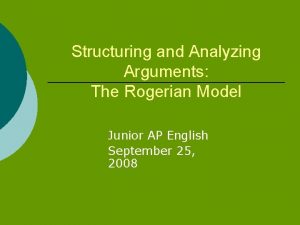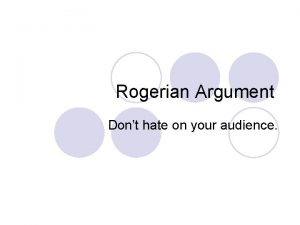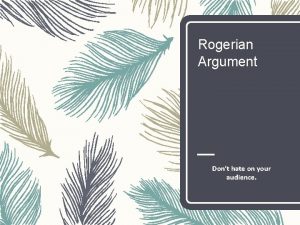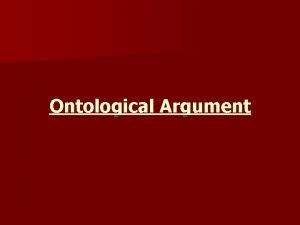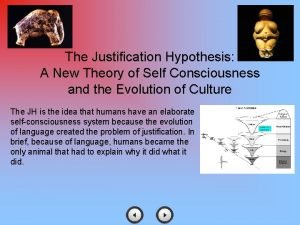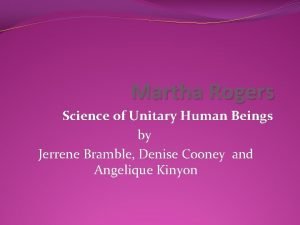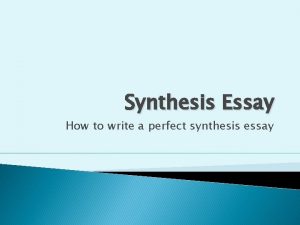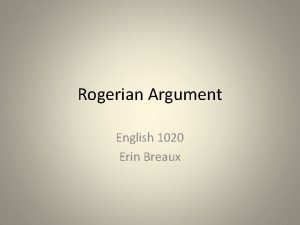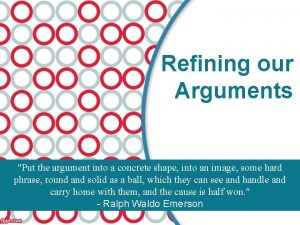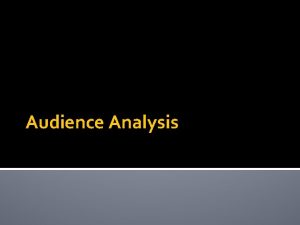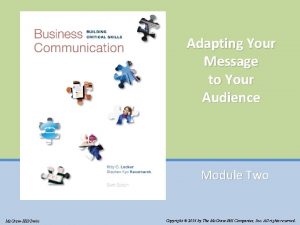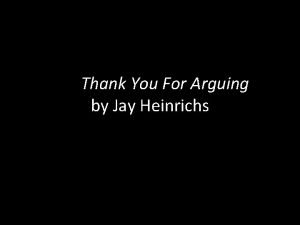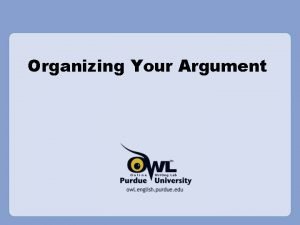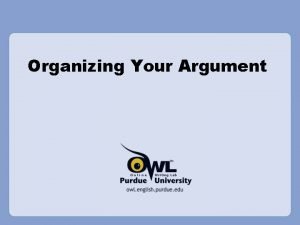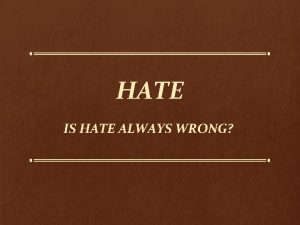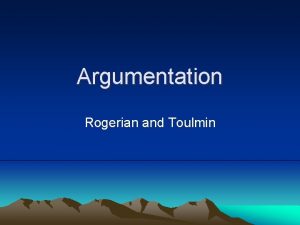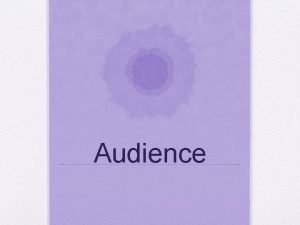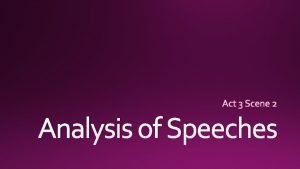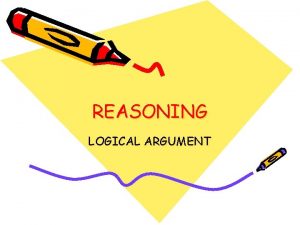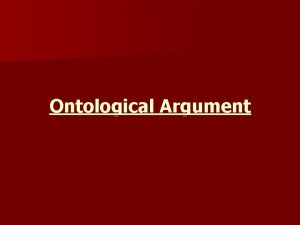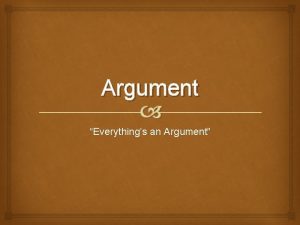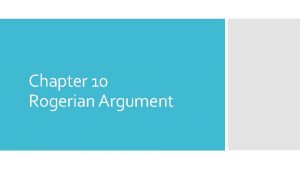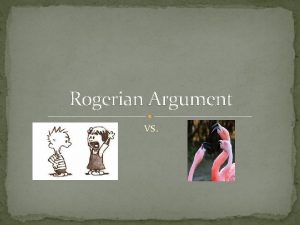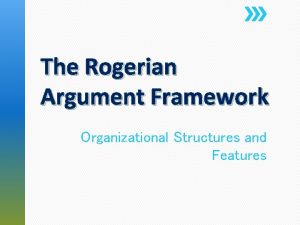Rogerian Argument Dont hate on your audience Rogerian






























- Slides: 30

Rogerian Argument Don’t hate on your audience.

Rogerian “Argument” – Ideas come from psychologist Carl Rogers

A few quotes… – “Real communication occurs when we listen with understanding” – Carl Rogers – “The first duty of a wise advocate is to convince his opponents that he understands their arguments, and sympathizes with their just feelings. ” –Samuel Taylor Coleridge (English Romantic Poet) – “You can catch more flies with honey than you can with vinegar” -? ?

You don’t pick fights with your audience! – Acknowledges the audience’s point of view before presenting the author’s opposing viewpoint. – Supports the central argument without outright attacking the audience’s preconceived notions.

Argument v. Persuasion – Definitions tend to be “academic” – Some say argument is purely logical, and persuasion contains emotional appeals. – ARGUMENT = discover a truth or conviction – PERSUASION = seeks to change a point of view or ACT on a conviction

Rogerian Argument – Seeks to establish trust and find COMMON GROUND. – Assumes that audience is comprised of REASONABLE people. – The fault with this model – Seeks to UNDERSTAND the point of view of those with whom they disagree – To start a DIALOGUE or DISCOURSE – BOTH/AND instead of EITHER/OR – WIN/WIN instead of WIN/LOSE

Courtroom Example: When you would NOT use Rogerian techniques… • Prosecution and defense argue with EACH OTHER - but the AUDIENCE is really the judge and jury. • In this case, there is no need to be nice or concede ANY points to the opposition. Your goal is to WIN!!

Same Thing with DEBATES: The OPPONENT is not the AUDIENCE, so you might not see many Rogerian techniques when you watch debates! The goal is to WIN!

Sometimes the Loser of the Debate Is (eventually) the Winner…

How a Rogerian Argument “Looks” – Intro – Summary of Opposing Views – Statement of Understanding – Statement of Your position – Statement of Contexts – Statement of Benefits – Important parts/pose a solution – here is where you “concede” something to the opposing side and acknowledge that others who think differently from you are also intelligent, reasonable people.

Things that Happen in a Rogerian Argument – The Speaker: – Shows (sympathetic) understanding to the opposition. – Demonstrates that those who disagree with them are still reasonable, intelligent people of good will (not fools and idiots). – Is non-confrontational, even friendly (not “my way or the highway”).

The Invitational Argument “Can’t we all just get along? ”

Goal – Based on three principles: – Equality – Intrinsic value – Self-determination – Aims not to win over another person – To enter a space of mutual regard and exploration – To promote understanding

– Many narrative essays are invitational arguments. – “Graduation” – “Once More to the Lake” – “The Movie that Changed My Life” – “Shooting an Elephant”

The Toulmin Model A tool for diagramming “informal” arguments

The four basic elements: – Claim (assertion or proposition) – Grounds (proof, grounds, support) – Warrant (inferential leap) – Qualifier (limitations on the claim)

Claims – A claim is the point an arguer is trying to make. The claim is the conclusion, proposition, or assertion an arguer wants another to accept. – The claim answers the question, "So what is your point? ” – example: “Rosario is an American citizen because she was born Rosario is an American citizen in the United States. ” – example: “Ellen is going to be a judge on American Idol, so the show will be more popular than ever. ”

More about claims. . . – There are four basic types of claims: – fact: claims which focus on empirically verifiable phenomena – judgment/value: claims involving opinions, attitudes, and subjective evaluations of things – policy: claims advocating courses of action that should be undertaken – definition/classification: indicates what criteria are being used to to define a term or what category something falls into

Grounds (proof or data) – Grounds refers to the proof or evidence an arguer offers. – Grounds can consist of statistics, quotations, reports, findings, physical evidence, or various forms of reasoning – example: “I’m a vegetarian. One reason is that I feel sorry for the animals. Another reason is to improve my health. ” – example: “I made the dinner, so you can do the dishes. “I made the dinner,

More about grounds. . . – Grounds are the support the arguer offers on behalf of his/her claim. The grounds answer questions such as: – "What is your proof? “ – "How do you know? “ – "Why? ” – example: “It looks like rain. The barometer is falling. ” The barometer is falling – example: "The other Starbucks I’ve been in had Wi-Fi, so I'll bet The other Starbucks I’ve been in had Wi-Fi this one does too. "

Still more about grounds. . . – grounds can be based on: – evidence: facts, statistics, reports, or physical proof – source credibility: authorities, experts, celebrity endorsers, a close friend, or someone's say-so – analysis and reasoning: reasons may be offered as proof – premises already held by the listener

Clue words for identifying grounds – The grounds for an argument often follow words such as “because, ” “since, ” “given that…” – example: “Airports should x-ray all luggage because a bomb could be placed in a checked baggage. ” – example: “I expect to do well on the test, since I studied all night for it. ”

Warrants – The warrant is the inferential leap that connects the claim with the grounds. – The warrant is typically implicit (unstated) and requires the listener to recognize the connection between the claim and grounds – The implicit nature of warrants means the “meaning” of an argument is as much a part of the receiver as it is a part of the message. – Some arguments are “multi-warranted, ” e. g. , based on more than one inferential leap

More about warrants. . . – The warrant performs a "linking" function by establishing a mental connection between the grounds and the claim – example: “Muffin is running a temperature. I’ll bet she has an infection. ” (warrant: sign reasoning; a fever is a reliable sign of an infection) – example: "That dog is probably friendly. It is a Golden Retriever. ” (warrant: generalization; most or all Golden Retrievers are friendly)

Still more about warrants. . . – warrants can be based on: – ethos: source credibility, authority – logos: reason-giving, induction, deduction – pathos: emotional or motivational appeals – value premises: values shared by, or presumed to be shared by, the receiver(s) – Note: these categories are not mutually exclusive; there is considerable overlap among them.

the first triad sample argument 1 The Dodgers are likely to win the ballgame tonight. Claim They are playing at home. Grounds Warrant (unstated) Generalization: The home team enjoys an advantage in baseball.

the first triad sample argument 2 It was nominated for 10 Academy Awards. Slumdog Millionaire is a wonderful movie. Grounds Claim Warrant (unstated) Sign: A movie’s greatness can be measured in the number of Oscar nominations it receives.

the first triad sample argument 3 Biff was probably in a fight. He has a black eye. Grounds Claim Warrant (unstated) Sign: A black eye is a reliable indicator that a person has been in a fight. What is the problem with this warrant? ? ?

the first triad sample argument 4 If you surf at Huntington Beach right after it rains, you risk getting a bacterial infection. Runoff from the rain washes bacteria into the ocean. Claim Grounds Warrant (unstated) Cause-effect: Bacteria in the water causes surfers to get ill.

Limitations regarding the Toulmin model – Offers a somewhat static view of an argument – Focuses on the argument maker, not the target or respondent – Real-life arguments not always neat or clear – An analytical tool: – Useful for dissecting arguments before or after they’ve been made – Not as useful, practical in the “heat” of an argument – Since warrants are unstated, different listeners may perceive them differently.
 Dont ask dont tell political cartoon
Dont ask dont tell political cartoon Don't laugh at me allen shamblin
Don't laugh at me allen shamblin Rogerian argument outline
Rogerian argument outline Rogerian method
Rogerian method Rogerian argument outline
Rogerian argument outline Rogerian format
Rogerian format Rogerian argument example
Rogerian argument example Audience addressed audience invoked
Audience addressed audience invoked Teleological vs ontological
Teleological vs ontological I bet you
I bet you Dont sacrifice pervades your mahal india
Dont sacrifice pervades your mahal india Give us your hungry your tired your poor
Give us your hungry your tired your poor Justification hypothesis
Justification hypothesis Pronuntatio
Pronuntatio Carl rogers theory
Carl rogers theory Martha rogers' theory application
Martha rogers' theory application Rogerian model
Rogerian model Rogerian model example
Rogerian model example Rogerian model
Rogerian model Analyze your audience
Analyze your audience 'adapting the message to your audience
'adapting the message to your audience Respect the audience
Respect the audience Audience analysis example
Audience analysis example Thank the audience
Thank the audience Knowing your audience
Knowing your audience Open your eyes the invisible argument
Open your eyes the invisible argument What is an argument
What is an argument Organizing your argument
Organizing your argument How to start a counterclaim example
How to start a counterclaim example What they don't know won't hurt them
What they don't know won't hurt them Dont remplace
Dont remplace


